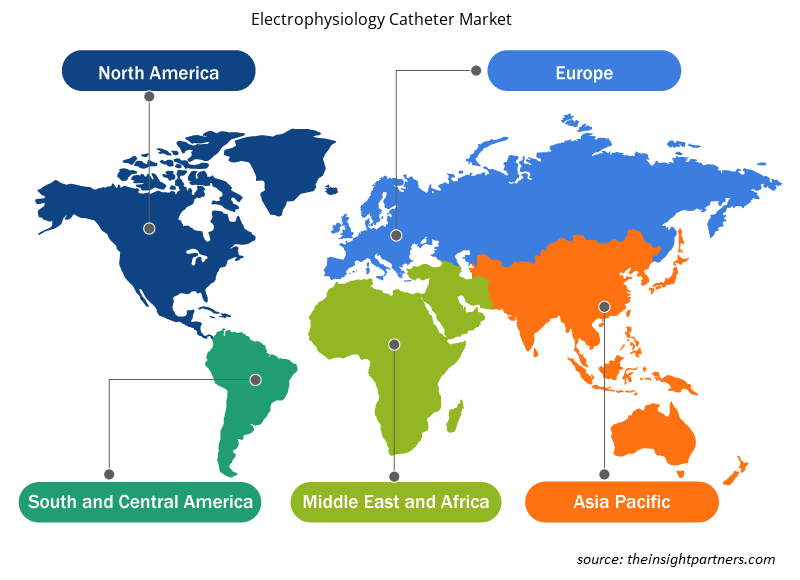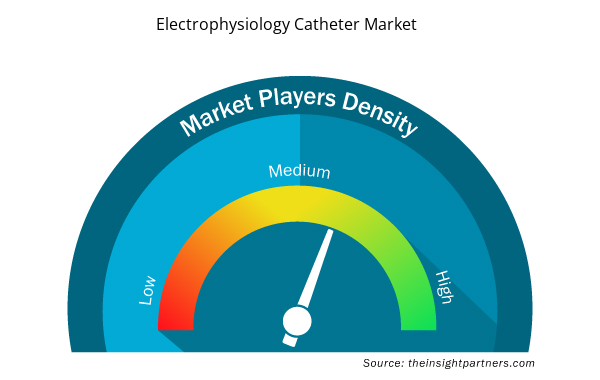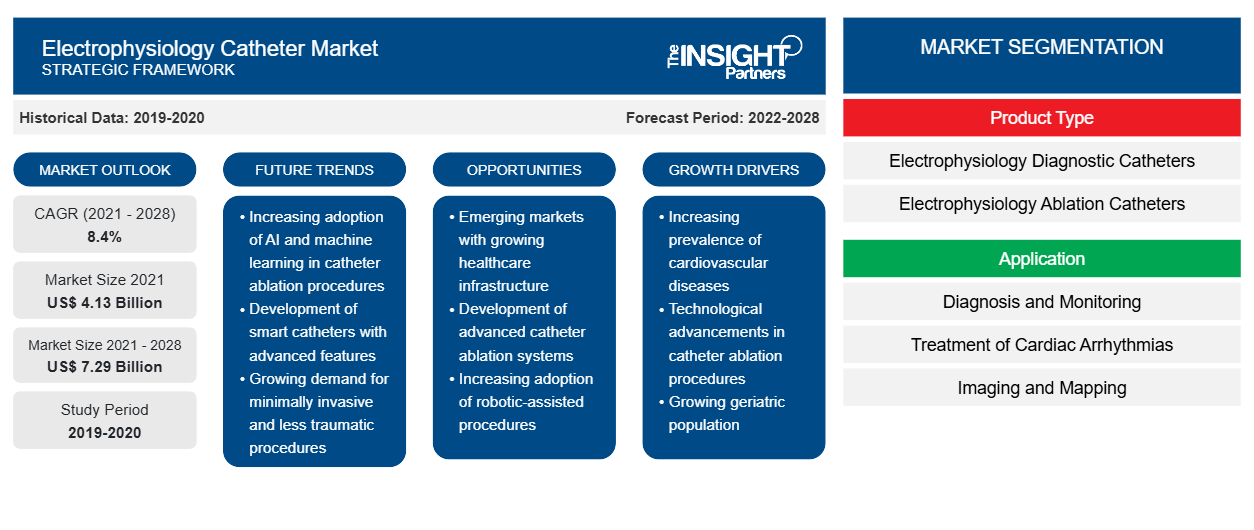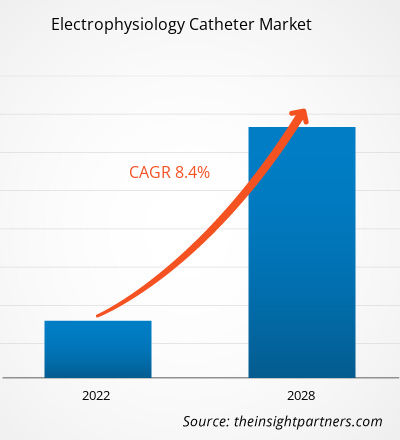Si prevede che il mercato dei cateteri per elettrofisiologia raggiungerà i 7.288,50 milioni di dollari entro il 2028, rispetto ai 4.133,18 milioni di dollari del 2021. Si stima che il mercato crescerà a un CAGR dell'8,4% dal 2021 al 2028.
L'ambito del mercato dei cateteri per elettrofisiologia include tipo di prodotto, applicazione, utente finale e geografia. In base alla regione, il mercato dei cateteri per elettrofisiologia è segmentato in Nord America, Europa, Asia Pacifico, Medio Oriente e Africa e Sud e Centro America. Il rapporto offre approfondimenti e analisi approfondite del mercato dei cateteri per elettrofisiologia, sottolineando vari parametri come tendenze e opportunità di mercato, dinamiche di mercato e analisi del panorama competitivo dei principali attori del mercato in Nord America, Europa, Asia Pacifico, Medio Oriente e Africa e Sud e Centro America. Include anche l'analisi dell'impatto del COVID-19 nelle regioni.
Personalizza questo report in base alle tue esigenze
Riceverai la personalizzazione gratuita di qualsiasi report, comprese parti di questo report, o analisi a livello nazionale, pacchetto dati Excel, oltre a usufruire di grandi offerte e sconti per start-up e università
- Scopri le principali tendenze di mercato in questo rapporto.Questo campione GRATUITO includerà analisi di dati che spaziano dalle tendenze di mercato alle stime e alle previsioni.
Approfondimenti di mercato
Il progresso tecnologico alimenta il mercato globale dei cateteri per elettrofisiologia
Il continuo miglioramento della scienza medica e i continui progressi tecnologici hanno portato a un'estensione della longevità e a una migliore qualità della vita. Sviluppi come l'introduzione di sistemi EAM tridimensionali (3D) hanno un'influenza duratura sulla visualizzazione del catetere, sulla mappatura dell'aritmia e sulla riduzione ed eliminazione dell'esposizione alla fluoroscopia/radiazioni nell'elettrofisiologia cardiaca . Il rapporto Frontiers SA afferma che oltre al continuo miglioramento dei sistemi di mappatura esistenti, il mercato globale è notevolmente guidato dal lancio di diversi nuovi strumenti negli ultimi anni. Ad esempio, Philips ha recentemente lanciato un nuovo sistema di imaging e navigazione non fluoroscopico basato su dielettrico, denominato KODEX-EPD. Il sistema genera immagini anatomiche cardiache 3D ad alta risoluzione senza la necessità di un contatto diretto catetere-tessuto o di imaging pre-acquisito. Inoltre, ha un elevato potenziale rappresentando una piattaforma aperta che consente procedure di alta qualità riducendo i costi e l'onere per il paziente. L'obiettivo di progettazione dell'azienda per i cateteri elettrofisiologici è quello di incorporare funzionalità che migliorino i risultati per pazienti e medici riducendo i costi per gli operatori sanitari. Inoltre, a settembre 2020, Acutus Medical ha annunciato di aver ricevuto l'autorizzazione FDA 510 (k) per il suo catetere di mappatura e imaging 3D AcQMap di seconda generazione. Questo nuovo prodotto è l'unico catetere di mappatura senza contatto e imaging basato su ultrasuoni ad alta risoluzione integrato al mondo in grado di catturare informazioni di imaging cardiaco, portando a una spinta verso l'alto nella crescita del mercato.
Informazioni basate sul tipo di prodotto
In base al tipo di prodotto, il mercato dei cateteri elettrofisiologici è segmentato in cateteri diagnostici elettrofisiologici e cateteri per ablazione elettrofisiologica. I cateteri diagnostici elettrofisiologici sono sottosegmentati come cateteri diagnostici elettrofisiologici convenzionali, cateteri diagnostici elettrofisiologici avanzati e cateteri diagnostici elettrofisiologici a ultrasuoni. Inoltre, i cateteri per ablazione elettrofisiologica sono sottosegmentati come cateteri elettrofisiologici per crioablazione, cateteri per ablazione a radiofrequenza, sistemi di ablazione a microonde e sistemi di ablazione laser. Il segmento dei cateteri diagnostici elettrofisiologici ha detenuto la quota maggiore del mercato nel 2021 e si prevede che lo stesso segmento registrerà il CAGR più elevato dell'8,8% nel mercato durante il periodo di previsione.
Approfondimenti basati sulle applicazioni
In base all'applicazione, il mercato dei cateteri per elettrofisiologia è segmentato in diagnosi e monitoraggio, trattamento delle aritmie cardiache e imaging e mappatura. Il segmento di diagnosi e monitoraggio ha detenuto la quota maggiore del mercato nel 2021 e si prevede che lo stesso segmento registrerà il CAGR più elevato del 9,0% nel mercato durante il periodo di previsione.
Informazioni basate sull'utente finale
In base all'utente finale, il mercato dei cateteri per elettrofisiologia è segmentato in ospedali, centri chirurgici ambulatoriali e laboratori di cateterizzazione cardiaca. Il segmento ospedaliero ha detenuto la quota maggiore del mercato nel 2021 e si prevede che lo stesso segmento registrerà il CAGR più elevato dell'8,7% nel mercato durante il periodo di previsione.
Le aziende adottano comunemente strategie inorganiche come fusioni e acquisizioni per soddisfare la domanda mutevole dei clienti e mantenere il loro marchio in tutto il mondo. Gli operatori di mercato che operano nel mercato dei cateteri per elettrofisiologia adottano anche strategie organiche come il lancio e l'espansione del prodotto per estendere la loro impronta e il portafoglio di prodotti in tutto il mondo e soddisfare la domanda crescente.
Approfondimenti regionali sul mercato dei cateteri per elettrofisiologia
Le tendenze regionali e i fattori che influenzano il mercato dei cateteri per elettrofisiologia durante il periodo di previsione sono stati ampiamente spiegati dagli analisti di Insight Partners. Questa sezione discute anche i segmenti e la geografia del mercato dei cateteri per elettrofisiologia in Nord America, Europa, Asia Pacifico, Medio Oriente e Africa e America meridionale e centrale.

- Ottieni i dati specifici regionali per il mercato dei cateteri elettrofisiologici
Ambito del rapporto di mercato del catetere elettrofisiologico
| Attributo del report | Dettagli |
|---|---|
| Dimensioni del mercato nel 2021 | 4,13 miliardi di dollari USA |
| Dimensioni del mercato entro il 2028 | 7,29 miliardi di dollari USA |
| CAGR globale (2021 - 2028) | 8,4% |
| Dati storici | 2019-2020 |
| Periodo di previsione | 2022-2028 |
| Segmenti coperti | Per tipo di prodotto
|
| Regioni e Paesi coperti | America del Nord
|
| Leader di mercato e profili aziendali chiave |
|
Densità degli attori del mercato: comprendere il suo impatto sulle dinamiche aziendali
Il mercato dei cateteri per elettrofisiologia sta crescendo rapidamente, spinto dalla crescente domanda degli utenti finali dovuta a fattori quali l'evoluzione delle preferenze dei consumatori, i progressi tecnologici e una maggiore consapevolezza dei benefici del prodotto. Con l'aumento della domanda, le aziende stanno ampliando le loro offerte, innovando per soddisfare le esigenze dei consumatori e capitalizzando sulle tendenze emergenti, il che alimenta ulteriormente la crescita del mercato.
La densità degli operatori di mercato si riferisce alla distribuzione di aziende o società che operano in un particolare mercato o settore. Indica quanti concorrenti (operatori di mercato) sono presenti in un dato spazio di mercato in relazione alle sue dimensioni o al valore di mercato totale.
Le principali aziende che operano nel mercato dei cateteri per elettrofisiologia sono:
- Ospedale medico St. Jude (Abbott)
- Società scientifica di Boston
- Società per azioni Stryker
- Medtronic
- Sistemi Transonic Inc.
Disclaimer : le aziende elencate sopra non sono classificate secondo un ordine particolare.

- Ottieni la panoramica dei principali attori del mercato dei cateteri per elettrofisiologia
Per tipo di prodotto
- Cateteri diagnostici per elettrofisiologia
- Cateteri diagnostici per elettrofisiologia convenzionale
- Cateteri diagnostici avanzati per elettrofisiologia
- Cateteri diagnostici per elettrofisiologia ad ultrasuoni
- Cateteri per ablazione elettrofisiologica
- Cateteri per elettrofisiologia crioablazione
- Cateteri per ablazione a radiofrequenza
- Sistemi di ablazione a microonde
- Sistemi di ablazione laser
Per applicazione
- Diagnosi e monitoraggio
- Trattamento delle aritmie cardiache
- Imaging e mappatura
Per utente finale
- Ospedali
- Centri chirurgici ambulatoriali
- Laboratori di cateterizzazione cardiaca
Per Geografia
- America del Nord
- NOI
- Canada
- Messico
- Europa
- Regno Unito
- Germania
- Francia
- Italia
- Spagna
- Resto d'Europa
- Asia Pacifico
- Cina
- Giappone
- India
- Australia
- Corea del Sud
- Resto dell'Asia Pacifica
- Medio Oriente e Africa
- Arabia Saudita
- Sudafrica
- Emirati Arabi Uniti
- Resto del Medio Oriente e Africa
- America del Sud e Centro
- Brasile
- Argentina
- Resto del Sud e Centro America
Profili aziendali
- Ospedale medico St. Jude (Abbott)
- Società scientifica di Boston
- Società per azioni Stryker
- Medtronic
- Sistemi Transonic Inc.
- CathRx Ltd
- APT MEDICAL INC.
- Società scientifica MicroPort
- Biosense Webster (Johnson and Johnson Services, Inc.)
- Biotronik, Inc.
- Analisi storica (2 anni), anno base, previsione (7 anni) con CAGR
- Analisi PEST e SWOT
- Valore/volume delle dimensioni del mercato - Globale, regionale, nazionale
- Industria e panorama competitivo
- Set di dati Excel



Report Coverage
Revenue forecast, Company Analysis, Industry landscape, Growth factors, and Trends

Segment Covered
This text is related
to segments covered.

Regional Scope
North America, Europe, Asia Pacific, Middle East & Africa, South & Central America

Country Scope
This text is related
to country scope.
Domande frequenti
With COVID-19 continuing to spread all over the world, researchers are looking into numerous options for possible treatment, including existing options. The pandemic of COVID-19 has had a significant impact on clinical medicine. Because so many resources have been poured into caring for those afflicted with the virus, elective medical treatments have reduced. The rates of atrial fibrillation ablation and implanted cardioverter-defibrillators (ICD) implantation fell faster than the rates of ventricular tachycardia (VT) ablation and device generator changes, indicating a shift away from elective medical operations. Telemedicine and digital health platforms proved effective during the pandemic as it was largely limited pre-pandemic due to technical and reimbursement barriers. But in the current COVID-19 crisis, the adoption of virtual medical services has grown tremendously and is projected to grow steadily in the coming years. For example, The Centers for Medicare and Medicaid Services have expanded telehealth services to keep people safe and assist healthcare providers to focus on individuals requiring the most dire healthcare needs.
Global electrophysiology catheters market is segmented by region into North America, Europe, Asia Pacific, Middle East & Africa and South & Central America. In North America, the U.S. is the largest market for electrophysiology catheters. The growth of this market is primarily driven by the increasing prevalence of cardiovascular disorders and growing number of product launches by key players. The presence of well-established healthcare facilities coupled with infrastructure and high prevalence of arrhythmia and heart failure cases accounts for significant revenue till the forecast period. Heart disease is the leading cause of death in the US, resulting in recording approx. 647,000 deaths per year as per the Centers for Disease Control and Prevention (CDC).
Johnson and Johnson Services, Inc. and Abbott are the top two companies that hold huge market shares in the electrophysiology catheters market.
The electrophysiology catheters market majorly consists of the players such St. Jude Medical (Abbott), Boston Scientific Corporation, Stryker Corporation, Medtronic, Transonic Systems Inc., CathRx Ltd, APT MEDICAL INC., MicroPort Scientific Corporation, Biosense Webster (Johnson and Johnson Services, Inc.), and Biotronik, Inc. among others.
The electrophysiology diagnostic catheters segment held the largest share of the market in the global electrophysiology catheters market and held the largest market share of 60.36% in 2021.
The diagnosis segment dominated the global electrophysiology catheters market and accounted for the largest market share of 50.24% in 2021.
The hospitals segment dominated the global electrophysiology catheters market and held the largest market share of 60.55% in 2021.
Electrophysiology catheters are designed to be used for better compatibility to perform standard electrophysiology studies. The catheter comprises of compatible stimulators/amplifiers that are purchased separately by the operator. Depending on the features of the simulator/amplifier, pacing, and recording protocols can be performed inside the human's body to determine abnormalities. For example, electrophysiology catheters are performed inside the heart (intracardiac) or through the esophagus (transesophageal) for determining electrical properties of the atrium and ventricle. Diagnostic electrophysiology (EP) catheters are used for temporary intra-cardiac sensing, recording, stimulation, and mapping.
Key factors that are driving the growth of this market are prevalence of cardiovascular disorders and technological advancement in electrophysiology catheters are expected to boost the market growth for the electrophysiology catheters over the years.
The CAGR value of the electrophysiology catheters market during the forecasted period of 2021-2028 is 8.4%.
Trends and growth analysis reports related to Life Sciences : READ MORE..
The List of Companies - Electrophysiology Catheters Market
- St. Jude Medical (Abbott)
- Boston Scientific Corporation
- Stryker Corporation
- Medtronic
- Transonic Systems Inc.
- CathRx Ltd
- APT MEDICAL INC.
- MicroPort Scientific Corporation
- Biosense Webster (Johnson and Johnson Services, Inc.)
- Biotronik, Inc.
The Insight Partners performs research in 4 major stages: Data Collection & Secondary Research, Primary Research, Data Analysis and Data Triangulation & Final Review.
- Data Collection and Secondary Research:
As a market research and consulting firm operating from a decade, we have published and advised several client across the globe. First step for any study will start with an assessment of currently available data and insights from existing reports. Further, historical and current market information is collected from Investor Presentations, Annual Reports, SEC Filings, etc., and other information related to company’s performance and market positioning are gathered from Paid Databases (Factiva, Hoovers, and Reuters) and various other publications available in public domain.
Several associations trade associates, technical forums, institutes, societies and organization are accessed to gain technical as well as market related insights through their publications such as research papers, blogs and press releases related to the studies are referred to get cues about the market. Further, white papers, journals, magazines, and other news articles published in last 3 years are scrutinized and analyzed to understand the current market trends.
- Primary Research:
The primarily interview analysis comprise of data obtained from industry participants interview and answers to survey questions gathered by in-house primary team.
For primary research, interviews are conducted with industry experts/CEOs/Marketing Managers/VPs/Subject Matter Experts from both demand and supply side to get a 360-degree view of the market. The primary team conducts several interviews based on the complexity of the markets to understand the various market trends and dynamics which makes research more credible and precise.
A typical research interview fulfils the following functions:
- Provides first-hand information on the market size, market trends, growth trends, competitive landscape, and outlook
- Validates and strengthens in-house secondary research findings
- Develops the analysis team’s expertise and market understanding
Primary research involves email interactions and telephone interviews for each market, category, segment, and sub-segment across geographies. The participants who typically take part in such a process include, but are not limited to:
- Industry participants: VPs, business development managers, market intelligence managers and national sales managers
- Outside experts: Valuation experts, research analysts and key opinion leaders specializing in the electronics and semiconductor industry.
Below is the breakup of our primary respondents by company, designation, and region:

Once we receive the confirmation from primary research sources or primary respondents, we finalize the base year market estimation and forecast the data as per the macroeconomic and microeconomic factors assessed during data collection.
- Data Analysis:
Once data is validated through both secondary as well as primary respondents, we finalize the market estimations by hypothesis formulation and factor analysis at regional and country level.
- Macro-Economic Factor Analysis:
We analyse macroeconomic indicators such the gross domestic product (GDP), increase in the demand for goods and services across industries, technological advancement, regional economic growth, governmental policies, the influence of COVID-19, PEST analysis, and other aspects. This analysis aids in setting benchmarks for various nations/regions and approximating market splits. Additionally, the general trend of the aforementioned components aid in determining the market's development possibilities.
- Country Level Data:
Various factors that are especially aligned to the country are taken into account to determine the market size for a certain area and country, including the presence of vendors, such as headquarters and offices, the country's GDP, demand patterns, and industry growth. To comprehend the market dynamics for the nation, a number of growth variables, inhibitors, application areas, and current market trends are researched. The aforementioned elements aid in determining the country's overall market's growth potential.
- Company Profile:
The “Table of Contents” is formulated by listing and analyzing more than 25 - 30 companies operating in the market ecosystem across geographies. However, we profile only 10 companies as a standard practice in our syndicate reports. These 10 companies comprise leading, emerging, and regional players. Nonetheless, our analysis is not restricted to the 10 listed companies, we also analyze other companies present in the market to develop a holistic view and understand the prevailing trends. The “Company Profiles” section in the report covers key facts, business description, products & services, financial information, SWOT analysis, and key developments. The financial information presented is extracted from the annual reports and official documents of the publicly listed companies. Upon collecting the information for the sections of respective companies, we verify them via various primary sources and then compile the data in respective company profiles. The company level information helps us in deriving the base number as well as in forecasting the market size.
- Developing Base Number:
Aggregation of sales statistics (2020-2022) and macro-economic factor, and other secondary and primary research insights are utilized to arrive at base number and related market shares for 2022. The data gaps are identified in this step and relevant market data is analyzed, collected from paid primary interviews or databases. On finalizing the base year market size, forecasts are developed on the basis of macro-economic, industry and market growth factors and company level analysis.
- Data Triangulation and Final Review:
The market findings and base year market size calculations are validated from supply as well as demand side. Demand side validations are based on macro-economic factor analysis and benchmarks for respective regions and countries. In case of supply side validations, revenues of major companies are estimated (in case not available) based on industry benchmark, approximate number of employees, product portfolio, and primary interviews revenues are gathered. Further revenue from target product/service segment is assessed to avoid overshooting of market statistics. In case of heavy deviations between supply and demand side values, all thes steps are repeated to achieve synchronization.
We follow an iterative model, wherein we share our research findings with Subject Matter Experts (SME’s) and Key Opinion Leaders (KOLs) until consensus view of the market is not formulated – this model negates any drastic deviation in the opinions of experts. Only validated and universally acceptable research findings are quoted in our reports.
We have important check points that we use to validate our research findings – which we call – data triangulation, where we validate the information, we generate from secondary sources with primary interviews and then we re-validate with our internal data bases and Subject matter experts. This comprehensive model enables us to deliver high quality, reliable data in shortest possible time.


 Ottieni un campione gratuito per questo repot
Ottieni un campione gratuito per questo repot